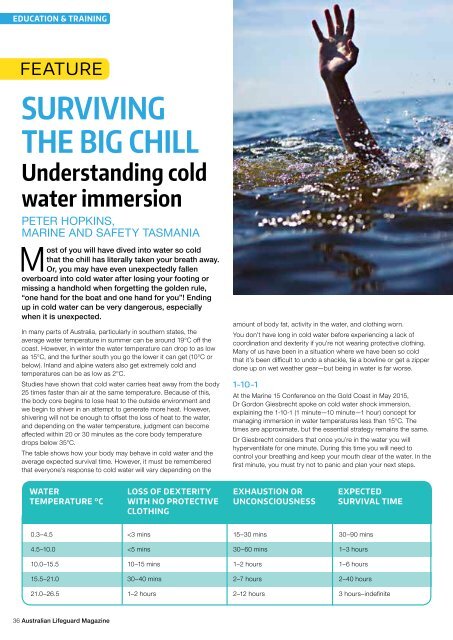isla
6YImNOtrh
6YImNOtrh
You also want an ePaper? Increase the reach of your titles
YUMPU automatically turns print PDFs into web optimized ePapers that Google loves.
education & Training<br />
education & Training<br />
Feature<br />
Surviving<br />
the Big Chill<br />
Understanding cold<br />
water immersion<br />
Peter Hopkins,<br />
Marine and Safety Tasmania<br />
“Hypothermia may not be the major cause<br />
of death in cold water immersion situations.<br />
Studies show that up to 60% of cold water<br />
immersion fatalities occur in the first 15<br />
minutes, before the body core temperature<br />
cools to hypothermic levels.”<br />
Most of you will have dived into water so cold<br />
that the chill has literally taken your breath away.<br />
Or, you may have even unexpectedly fallen<br />
overboard into cold water after losing your footing or<br />
missing a handhold when forgetting the golden rule,<br />
“one hand for the boat and one hand for you”! Ending<br />
up in cold water can be very dangerous, especially<br />
when it is unexpected.<br />
In many parts of Australia, particularly in southern states, the<br />
average water temperature in summer can be around 19°C off the<br />
coast. However, in winter the water temperature can drop to as low<br />
as 15°C, and the further south you go the lower it can get (10°C or<br />
below). Inland and alpine waters also get extremely cold and<br />
temperatures can be as low as 2°C.<br />
Studies have shown that cold water carries heat away from the body<br />
25 times faster than air at the same temperature. Because of this,<br />
the body core begins to lose heat to the outside environment and<br />
we begin to shiver in an attempt to generate more heat. However,<br />
shivering will not be enough to offset the loss of heat to the water,<br />
and depending on the water temperature, judgment can become<br />
affected within 20 or 30 minutes as the core body temperature<br />
drops below 35°C.<br />
The table shows how your body may behave in cold water and the<br />
average expected survival time. However, it must be remembered<br />
that everyone’s response to cold water will vary depending on the<br />
amount of body fat, activity in the water, and clothing worn.<br />
You don’t have long in cold water before experiencing a lack of<br />
coordination and dexterity if you’re not wearing protective clothing.<br />
Many of us have been in a situation where we have been so cold<br />
that it’s been difficult to undo a shackle, tie a bowline or get a zipper<br />
done up on wet weather gear—but being in water is far worse.<br />
1-10-1<br />
At the Marine 15 Conference on the Gold Coast in May 2015,<br />
Dr Gordon Giesbrecht spoke on cold water shock immersion,<br />
explaining the 1-10-1 (1 minute—10 minute—1 hour) concept for<br />
managing immersion in water temperatures less than 15°C. The<br />
times are approximate, but the essential strategy remains the same.<br />
Dr Giesbrecht considers that once you’re in the water you will<br />
hyperventilate for one minute. During this time you will need to<br />
control your breathing and keep your mouth clear of the water. In the<br />
first minute, you must try not to panic and plan your next steps.<br />
Water loss of dexterity Exhaustion or Expected<br />
Temperature °C with no protective unconsciousness survival time<br />
clothing<br />
0.3–4.5


